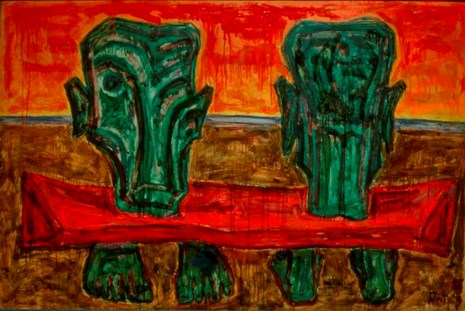Developments of art in Independent Lithuania were interrupted by the occupation of the USSR, which began in 1941. After the war, Lithuanian art divided into two branches: those who stayed in the country and those who emigrated to the West. Artists who were forced to leave Lithuania spread across North and South America, Australia and Europe; they cherished traditions of their country's art, but and also experienced influences of art in other countries. The collection of the Lithuanian Art Museum also includes paintings, sculptures and prints by some of the artists who worked in exile, including Paulius Augius-Augustinavičius, Alfonsas Dargis, Pranas Domšaitis, Albinas Elskus, Pranas Gailius, Adomas Galdikas, Vytautas Ignas, Vytautas Kazimieras Jonynas, Vytautas Kasiulis, Vytautas Kašuba, Petras Kiaulėnas, Pranas Lapė, Žibuntas Mikšys, Antanas Mončys, Vaclovas Ratas-Rataiskis, Vytas Sakalas, Magdalena Stankūnienė, Elena Urbaitytė, Telesforas Valius, Albertas Vesčiūnas, Romas Viesulas, Viktoras Vizgirda, Kęstutis Zapkus, Kazimieras Žoromskis and others.
During the post-war period, the socialist realism method was enforced on Lithuanian artists who remained in Lithuania. 'Thematic painting' was the most highly praised genre: scenes from the history of revolution and new communist life. Individuality and originality in style were restricted. During the post-Stalinist period artists were allowed more freedom. From the 1960s, the main goal of Lithuanian artists was the preservation of national identity and continuation of modernist traditions. Having no active direct links with Western art of the period, Lithuanian artists developed individual versions of realism, expressionism, surrealism, abstraction and other tendencies in modern art.
Collected works by artists who created during the second half of the 20th Century in Lithuania are particularly abundant and representative. The painting collection includes works by classical Lithuanian painters who began working in mid 20th Century, including Antanas Gudaitis, Leonas Katinas, Vytautas Mackevičius, Algirdas Petrulis and others, and also contains works by painters who emerged in the 1960s and 1970s: Valentinas Antanavičius, Vytautas Ciplijauskas, Eugenijus Antanas Cukermanas, Kostas Dereškevičius, Silvestras Džiaukštas, Vincentas Gečas, Leonardas Gutauskas, Dalia Kasčiūnaitė, Linas Katinas, Vincas Kisarauskas, Algimantas Kuras, Antanas Martinaitis, Augustinas Savickas, Mindaugas Skudutis, Raimundas Sližys, Leopoldas Surgailis, Aloyzas Stasiulevičius, Arvydas Šaltenis, Jonas Švažas, Algimantas Švėgžda, Leonardas Tuleikis, Povilas Ričardas Vaitiekūnas, Sofija Veiverytė and others. Also represented are artists who joined the art scene in the 1980s, such as Jonas Gasiūnas, Rimvydas Jankauskas (Kampas), Vilmantas Marcinkevičius, Ričardas Nemeikšis, Vygantas Paukštė, Audronė Petrašiūnaitė, Šarūnas Sauka, Mikalojus Šalkauskas, and Arūnas Vaitekūnas.
The variety in sculpture of the second half of the 20th century is represented by artists who emerged during the interwar period: Petras Aleksandravičius, Robertas Antinis, Juozas Kėdainis, Jonas Mikėnas and others; the main tendencies of the 1960s - 1980s are represented by: Alfonsas Ambraziūnas, Robertas Antinis (junior), Konstantinas Bogdanas, Algimantas Bosas, Ksenija Jeroševaitė, Gediminas Jokūbonis, Gediminas Karalius, Stanislovas Kuzma, Dalia Matulaitė, Petras Mazūras, Mindaugas Navakas, Leonas Strioga, Vytautas Šerys, Steponas Šarapovas, Šarūnas Šimulynas, Vladas Urbanavičius, Teodoras Kazimieras Valaitis, Vladas Vildžiūnas, Bronius Vyšniauskas and others, as well as sculptors of the youngest generation: Algis Lankelis, Artūras Raila, Mindaugas Šnipas, Gediminas Urbonas.
In the collection of prints, the graphic arts of the first decades of the post-war period are represented by prints and book illustrations by Vytautas Jurkūnas, Antanas Kučas, Jonas Kuzminskis, Petras Rauduvė and other artists; works by graphic artists of later decades, including Viktorija Daniliauskaitė, Irena Daukšaitė-Guobienė, Gražina Didelytė, Stasys Eidrigevičius, Rimtautas Gibavičius, Danutė Gražienė, Kęstutis Grigaliūnas, Eduardas Juchnevičius, Danutė Jonkaitytė, Vytautas Jurkūnas (junior), Vytautas Kalinauskas, Stasys Krasauskas, Arvydas Každailis, Leonas Lagauskas, Bronius Leonavičius, Albina Makūnaitė, Lili Janina Paškauskaitė, Audrius Puipa, Petras Repšys, Edmundas Saladžius, Aldona Skirutytė, Birutė Stančikaitė, Jūratė Stauskaitė, Algirdas Steponavičius, Aspazija Surgailienė, Domicelė Tarabildienė, Vytautas Valius, Kęstutis Vasiliūnas, Mikalojus Povilas Vilutis, Birutė Žilytė, and Alfonsas Žvilius are also present.
The second half of the 20th century photography collection includes works by the most famous Lithuanian photographers: Vytautas Balčytis, Violeta Bubelytė, Alfonsas Budvytis, Algimantas Kunčius, Vitas Luckus, Alvydas Lukys, Aleksandras Macijauskas, Remigijus Pačėsa, Romualdas Požerskis, Romualdas Rakauskas, Antanas Sutkus, Gintautas Trimakas, Artūras Valiauga, Rimaldas Vikšraitis and others.



